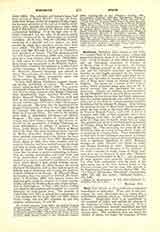

Birnbaum, HEINRICH (also known as DE PIRO, the latinized form of his German name), a pious and learned Carthusian monk, b. in 1403; d. February 19, 1473. Little is known of him before his entrance into the Carthusian monastery at Cologne on March 14, 1435, at the age of 32 years. On account of his edifying example in the observance of the rule and his extensive scriptural and theological learning he was highly esteemed by his confreres, and as early as 1438, only three years after his entrance into the order, he became prior of the monastery of Mont Saint Andre at Tournai (Doornik) in Belgium. The desire for a reform of the religious orders, which animated many great men of the fifteenth century, had also penetrated the soul of Birnbaum. Being a true reformer, he soon succeeded by the irresistible force of his own pious example, in abolishing the few abuses that had found admittance into the various monasteries over which he became prior, and in restoring the austere monastic discipline established by the founder St. Bruno. After holding the position of prior at Mont Saint Andre for eleven years, he was active in the same office successively at Wesel in Rhenish Prussia, until 1457; at Rettel in Lorraine, until 1459; at Trier, until 1461; and at Diest in Belgium, until 1463. In 1463 he was appointed prior at Liege, but ill health forced him to resign this position and retire to the Carthusian monastery at Cologne, where he had spent the first days of his monastic life. The remaining ten years of his life Birnbaum spent in writing several ascetic works and in preparing for a happy death. There were with him at that time in the Carthusian monastery of Cologne some of the most learned and saintly men of Germany, such as Hermann Appeldorn (d. 1472), Hermann Grefken (d. 1480), Heinrich von Dissen (d. 1484), and Werner Rolewink (d. 1502). Birnbaum wrote for the instruction and direction of the members of his order a number of works, many of which, however, have not yet been put in print, also: “Defensio pro Immaculato Conceptu B. M. V.”, and “Excerpta ex malo granato cum nonnullis conjunctis”. He has often been confounded with his uncle of the same name, one of the most learned jurists of the fifteenth century, who was for some time provost of St. Kunibert’s at Cologne, and who died in 1439. See “Le Grand Dictionnaire Historique” (Amsterdam, 1698), III, 138; also Jocher, “Gelehrten Lexicon”, III, 1589.
MICHAEL OTT

